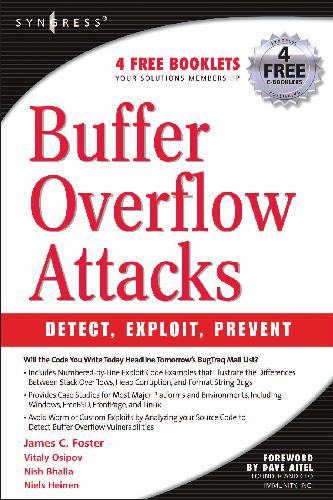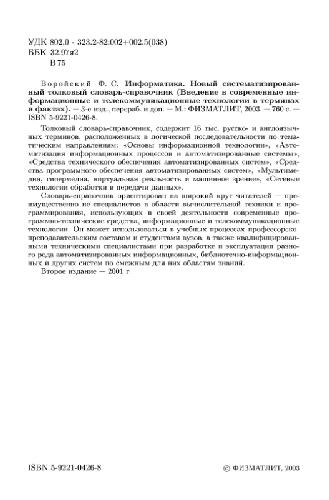Erik Pace Birkholz1931836698, 1931836744, 1932266658, 1932266674
Table of contents :
Team DDU……Page 1
Contents……Page 12
Foreword……Page 22
Part 1 Expanding on Buffer Overflows……Page 24
Introduction……Page 26
The Challenge of Software Security……Page 27
Microsoft Software Is Not Bug Free……Page 29
The Increase in Buffer Overflows……Page 31
Madonna Hacked!……Page 33
Hardware……Page 35
Software……Page 36
Security……Page 41
Solutions Fast Track……Page 43
Frequently Asked Questions……Page 46
Introduction……Page 48
The Tools……Page 49
The Assembly Programming Language……Page 50
Analysis……Page 51
Analysis……Page 52
Windows vsUnix Assembly……Page 54
Analysis……Page 55
Pushing the Arguments……Page 56
The NULL Byte Problem……Page 57
System Call Numbers……Page 58
Analysis……Page 59
Analysis……Page 60
Port-Binding Shellcode……Page 61
Analysis……Page 63
execve Shellcode……Page 64
setuid Shellcode……Page 66
chroot Shellcode……Page 67
Solutions Fast Track……Page 72
Mailing Lists……Page 74
Frequently Asked Questions……Page 75
Introduction……Page 78
Shellcode Examples……Page 79
The Write System Call……Page 81
Analysis……Page 83
Analysis……Page 84
Analysis……Page 86
Analysis……Page 87
Analysis……Page 89
Analysis……Page 91
Analysis……Page 93
Analysis……Page 94
Port-Binding Shellcode……Page 95
Analysis……Page 96
Analysis……Page 98
Analysis……Page 99
Analysis……Page 100
Analysis……Page 101
Analysis……Page 104
Reverse Connection Shellcode……Page 106
Analysis……Page 108
Socket Reusing Shellcode……Page 110
Analysis……Page 111
Analysis……Page 112
Analysis……Page 114
Analysis……Page 115
Analysis……Page 116
Analysis……Page 117
Analysis……Page 118
Encoding Shellcode……Page 119
Analysis……Page 120
Analysis……Page 122
Analysis……Page 124
Open Source Programs……Page 125
Analysis……Page 126
Closed Source Programs……Page 127
Analysis……Page 128
OS-Spanning Shellcode……Page 129
Understanding Existing Shellcode……Page 130
Analysis……Page 132
Solutions Fast Track……Page 135
Links to Sites……Page 136
Frequently Asked Questions……Page 137
Introduction……Page 140
Application Memory Layout……Page 141
Application Structure……Page 143
Memory Allocation-Stack……Page 144
Memory Allocation-Heap……Page 145
Heap Structure……Page 146
Registers……Page 147
Other General-Purpose Registers……Page 148
Operations……Page 149
Hello World……Page 150
Summary……Page 152
Solutions Fast Track……Page 153
Frequently Asked Questions……Page 154
Section 1 Case Studies……Page 155
Overview……Page 156
Exploitation Code Dump……Page 157
Analysis……Page 159
References……Page 160
Overview……Page 161
Exploitation Code Dump……Page 162
References……Page 164
Overview……Page 165
Code Dump……Page 166
Analysis……Page 167
Application Defense Hackh Code Dump……Page 168
Analysis……Page 174
References……Page 175
Overview……Page 177
Exploit Code……Page 178
Analysis……Page 180
References……Page 181
Part II Exploiting Buffer Overflows……Page 182
Introduction……Page 184
Intel x86 Architecture and Machine Language Basics……Page 186
Registers……Page 187
Stacks and Procedure Calls……Page 188
Storing Local Variables……Page 190
Introduction to the Stack Frame……Page 195
Passing Arguments to a Function……Page 196
Stack Frames and Calling Syntaxes……Page 203
Process Memory Layout……Page 204
Stack Overflows and Their Exploitation……Page 206
Simple Overflow……Page 208
Writing Overflowable Code……Page 212
Disassembling the Overflowable Code……Page 213
General Exploit Concepts……Page 215
Buffer Injection Techniques……Page 216
Methods to Execute Payload……Page 217
Designing Payload……Page 221
What Is an Off-by-One Overflow?……Page 227
gets() and fgets()……Page 234
strcpy() and strncpy(), strcat(), and strncat()……Page 235
sscanf(), vscanf(), and fscanf()……Page 236
Other Functions……Page 237
Challenges in Finding Stack Overflows……Page 238
Lexical Analysis……Page 240
Semantics-Aware Analyzers……Page 241
OpenBSD 28 ftpd Off-by-One……Page 243
Apache htpasswd Buffer Overflow……Page 244
Summary……Page 245
Solutions Fast Track……Page 247
Links to Sites……Page 248
Frequently Asked Questions……Page 250
Introduction……Page 252
Simple Heap Corruption……Page 253
Using the Heap-malloc(), calloc(), realloc()……Page 254
Simple Heap and BSS Overflows……Page 255
Corrupting Function Pointers in C++……Page 258
Overview of Doug Lea malloc……Page 261
Memory Organization-Boundary Tags, Bins, Arenas……Page 262
The free() Algorithm……Page 267
Fake Chunks……Page 269
Example Vulnerable Program……Page 271
Exploiting frontlink()……Page 273
Off-by-One and Off-by-Five on the Heap……Page 274
System V malloc Operation……Page 275
Tree Structure……Page 276
Freeing Memory……Page 278
The realfree() Function……Page 280
The t_delete Function-The Exploitation Point……Page 283
Fixing Heap Corruption Vulnerabilities in the Source……Page 286
Summary……Page 289
Solutions Fast Track……Page 290
Links to Sites……Page 291
Frequently Asked Questions……Page 293
Introduction……Page 296
C Functions with Variable Numbers of Arguments……Page 297
Ellipsis and va_args……Page 298
Functions of Formatted Output……Page 301
printf() Example……Page 303
Format Tokens and printf() Arguments……Page 304
Types of Format Specifiers……Page 305
Abusing Format Strings……Page 307
Playing with Bad Format Strings……Page 309
Direct Argument Access……Page 310
Reading Memory……Page 311
Simple Writes to Memory……Page 314
Multiple Writes……Page 317
Finding Format String Bugs……Page 319
What to Overwrite……Page 322
Destructors in dtors……Page 323
Global Offset Table entries……Page 325
Structured Exception Handlers……Page 327
Operating System Differences……Page 328
Application Defense!……Page 331
The Whitebox and Blackbox Analysis of Applications……Page 332
Solutions Fast Track……Page 334
Links to Sites……Page 336
Frequently Asked Questions……Page 337
Introduction……Page 340
Basic Stack Overflow……Page 341
Analysis……Page 345
Writing Windows Shellcode……Page 350
Overcoming Special Characters (Example: NULL)……Page 356
Client Server Application……Page 361
Using/Abusing the Structured Exception Handler……Page 373
Solutions Fast Track……Page 378
Frequently Asked Questions……Page 380
Section 2 Case Studies……Page 381
Overview……Page 382
Exploit Code……Page 383
Analysis……Page 385
References……Page 386
Overview……Page 387
Exploitation Details……Page 388
The Complication……Page 389
Analysis……Page 390
Much Improved… but More to Come!……Page 391
Complete Exploit Code for OpenSSL SSLv2 Malformed Client Key Remote Buffer Overflow……Page 392
References……Page 398
Overview……Page 399
XLOCALEDIR Vulnerability Details and Analysis……Page 400
Exploitation Code Dump……Page 402
References……Page 404
Overview……Page 405
Code Dump……Page 406
Analysis……Page 408
Application Defense Hackh Code Dump……Page 409
Analysis……Page 415
References……Page 417
Overview……Page 418
Exploit Code……Page 419
Analysis……Page 420
References……Page 422
Part III Finding Buffer Overflows……Page 424
Introduction……Page 426
Source Code Analysis……Page 427
Application Defense Snapshot……Page 429
RATS……Page 431
Flawfinder……Page 435
Flawfinder Text Output……Page 437
ITS4……Page 440
Application Defense-Enterprise Developer……Page 441
Architecture and Deployment……Page 446
Vulnerability Knowledgebase……Page 447
Using CodeAssure……Page 448
Performing the Analysis……Page 450
Vulnerability Review and Reporting……Page 451
Managing Results……Page 453
Ounce Labs……Page 455
Prexis’ Science of Automated Analysis……Page 456
Prexis Reporting and Remediation Capabilities……Page 457
Prexis in Action……Page 458
Running an Assessment……Page 459
Examining Assessment Results……Page 460
Remediation……Page 461
Fortify Software……Page 463
Using the Source Code Analysis Engine……Page 464
Integrating with the Build Process……Page 465
Understanding the Raw Output……Page 466
Audit Workbench……Page 467
Audit Guide……Page 468
Software Security Manager……Page 470
Summary……Page 472
Solutions Fast Track……Page 473
Links to Sites……Page 475
Frequently Asked Questions……Page 476
Section 3 Case Studies……Page 477
Overview……Page 478
Analysis……Page 479
References……Page 480
Overview……Page 481
Inline Egg Code……Page 482
Analysis……Page 483
References……Page 484
Exploitation Code Dump……Page 485
Analysis……Page 490
References……Page 492
Overview……Page 493
Exploitation Code Dump……Page 494
Analysis……Page 497
References……Page 498
Appendix A The Complete Data Conversion Table……Page 500
close( filedescriptor )……Page 508
socketcall(callnumber, arguments )……Page 509
accept ( file descriptor, sockaddr struct, size of arg 2 )……Page 510
Index……Page 512







Reviews
There are no reviews yet.